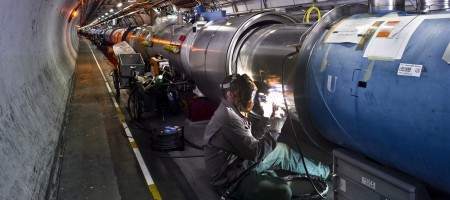The hunt for the elusive Higgs boson – rather misleadingly known as the God particle – may be nearing its end.

Scientists at CERN’s Large Hadron Collider say they’ve detected signals that appear to match the particle’s expected signature.
The results aren’t fully analyzed yet – and it’s perfectly possible that the ‘bumps’ in the data are merely a statistical phenomenon. But two of CERN’s detectors – ATLAS and CMS – have found excess particles in a similar range.
Previous work has indicated that the Higgs boson should have a mass somewhere between 114 and 185 GeV – and the ATLAS signal appears nicely within that range, showing excess particles between 120 and 140GeV. The CMS detector sees a similar bump, between 120 and 180GeV.
Meanwhile, scientists at Fermilab in the US are also helping narrow the search.
“Both the DZero and CDF experiments have now analyzed about two-thirds of the data that we expect to have at the end of the Tevatron run on September 30,” says Stefan Soldner-Rembold, co-spokesperson of the DZero experiment.
“In the coming months, we will continue to improve our analysis methods and continue to analyze our full data sets. The search for the Higgs boson is entering its most exciting, final stage.”
The Tevatron team says it’s detected what could be a signal at a similar range to the LHC, around the 140GeV mark.
The Higgs boson was first postulated in 1964 as an attempt to explain how particles come to have mass. While some particles, such as quarks, possess mass, others, such as photons, do not.
The theory is that they’re being affected by a field which gives mass to some and not others, and which is created by the so-far-unseen Higgs boson.
If it’s found, of course, it would confirm the validity of the Standard Model of particle physics, which explains how subatomic particles interact. But if future experiments rule it out, it’s back to the drawing board for physicists.






